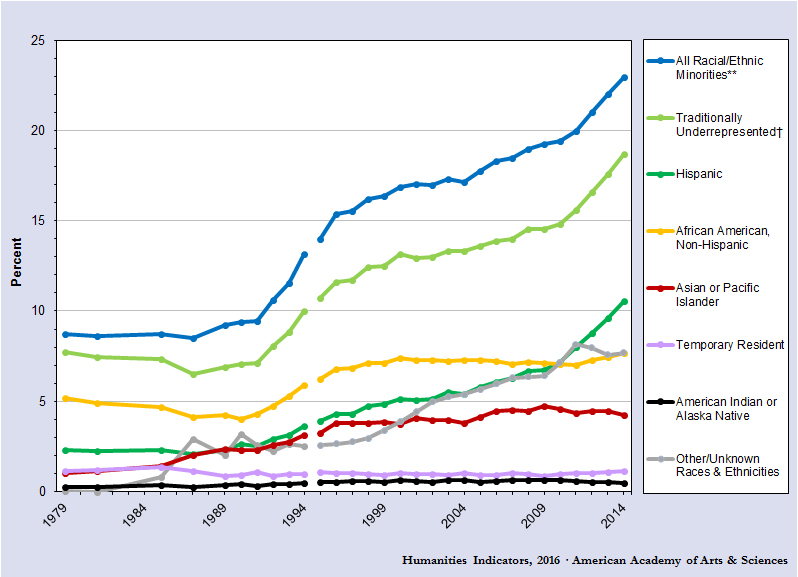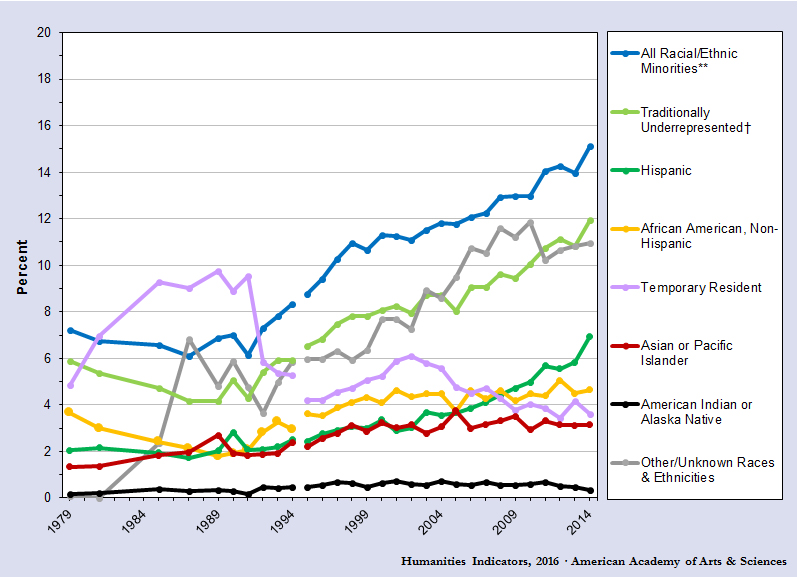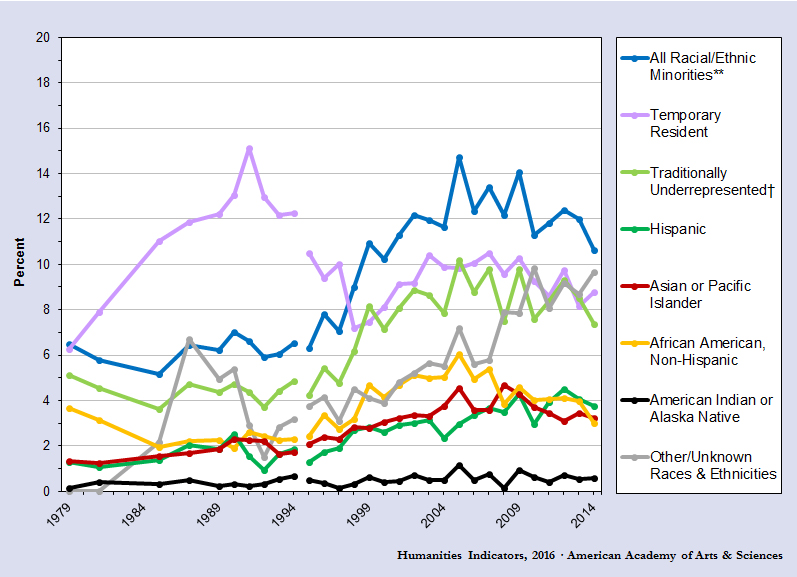Racial/Ethnic Distribution of Degrees in English Language and Literature
- The share of ELL bachelor’s recipients who were members of traditionally underrepresented racial/ethnic groups increased relatively quickly after 2010—rising from 14.8% to 18.7% in 2014 (Indicator II-41a). Over the previous decade, the percentage of underrepresented minorities earning the degree had grown just 1.7 percentage points. The 2014 percentage also marks a substantial increase from the 1979–1991 period (the earliest for which data are available), when traditionally underrepresented minorities accounted for 6.0–8.0% of the bachelor’s degree recipients in the discipline.
- The recent growth in the share of traditionally underrepresented minorities earning ELL degrees was largely due to an increase of more than three percentage points in the share of Hispanics receiving the degree from 2010 to 2014 (rising to 10.5%). In 2014, Hispanics constituted the largest share of minority students earning ELL degrees at the bachelor’s level, while the shares of students from other minority groups earning the degree were relatively unchanged from 2000 to 2014.
- In 2014, the share of ELL master’s degrees awarded to members of underrepresented racial/ethnic groups reached the highest level on record, 12.0% (Indicator II-41b). The share declined from the late 1970s through 1987, but by 1993 the share had regained its earlier level, and the proportion grew slowly but steadily from there.
- While the share of ELL master’s recipients from underrepresented racial/ethnic groups has been rising steadily in recent years, this trend has not translated into similar increases at the doctoral level (Indicator II-41c). From 1979 to 2005, the percentage of ELL Ph.D.’s received by minority students rose from 5.1% to a high of 10.2%. After 2005, the share fluctuated in the 7.5–10.0% range, before falling to a recent low of 7.4% in 2014.
- The bachelor’s and advanced degree levels differed in the share of degrees awarded to “temporary residents,” students who come from other nations to the United States to study and who are likely to return to their home countries upon graduation. At the undergraduate level, these students accounted for approximately 1.0% of degree recipients throughout the 1977–2014 period, a considerably smaller share than at the master’s or doctoral degree levels.
- At the master’s level, the share of degrees earned by “temporary residents” was close to 10.0% in the late 1980s and early 1990s. Although the percentage of master’s degrees going to these students then declined substantially, temporary residents still earned 3.6% of all master’s degrees conferred in ELL in 2014.
- At the doctoral level, “temporary residents” consistently earned a greater share of ELL Ph.D.’s than any U.S. minority group. The share was greatest in 1991, when temporary residents represented 15.1% of doctoral degree recipients (up from 6.3% in 1979). The share fell steadily over the next decade, before an uptick in the early 2000s. After rising to a recent high of 10.5% of all ELL doctorates in 2007, the percentage declined again, and stood at 8.8% in 2014.
II-41a: Percentages of Bachelor’s Degrees in English Language and Literature Awarded to Members of Racial/Ethnic Minority Groups, 1979–2014*

* The gaps in the trend lines indicate a shift from the National Science Foundation’s disciplinary classification system to the National Center for Education Statistics’ Classification of Instructional Programs. Data not published for all years. Degree counts and shares do not include second majors.
** Students counted under “Racial/Ethnic Minorities” (see below) minus Asians and Pacific Islanders.
† Includes students who are citizens or permanent residents and who are identified by their institutions as African American (non-Hispanic), American Indian/Alaska Native, Asian/Pacific Islander, or Hispanic.
Source: U.S. Department of Education, Institute of Education Sciences, National Center for Education Statistics, Integrated Postsecondary Data System; accessed via the National Science Foundation’s online integrated science and engineering resources data system, WebCASPAR.
See the Note on Data Used to Calculate Discipline-Specific Degree Counts and Shares, the Note on the Data Used to Calculate the Number of Degree Completions in English Language and Literature and in Languages and Literatures Other than English, the Note on the Definition of Advanced Degrees, and the Degree Program Code Catalog (for an inventory of the specific degree programs included by the Humanities Indicators under the heading of “English Language and Literature”).
The percentages do not include so-called double major degrees. When degrees are earned concurrently in this way, only the first degree is counted.
II-41b: Percentages of Master’s Degrees in English Language and Literature Awarded to Members of Racial/Ethnic Minority Groups, 1979–2014*

* The gaps in the trend lines indicate a shift from the National Science Foundation’s disciplinary classification system to the National Center for Education Statistics’ Classification of Instructional Programs. Please see the Note on the Data Used to Calculate the Number of Degree Completions in English Language and Literature and in Languages and Literatures Other than English for an explanation of the differences between the two systems that are most pertinent to this indicator. Data not published for all years.
** Includes students who are citizens or permanent residents and who are identified by their institutions as African American (non-Hispanic), American Indian/Alaska Native, Asian/Pacific Islander, or Hispanic.
† Students counted under “Racial/Ethnic Minorities” minus Asians and Pacific Islanders.
Source: U.S. Department of Education, Institute of Education Sciences, National Center for Education Statistics, Integrated Postsecondary Data System; accessed via the National Science Foundation’s online integrated science and engineering resources data system, WebCASPAR.
See the Note on Data Used to Calculate Discipline-Specific Degree Counts and Shares, the Note on the Data Used to Calculate the Number of Degree Completions in English Language and Literature and in Languages and Literatures Other than English, and the Note on the Definition of Advanced Degrees. See the Degree Program Code Catalog for an inventory of the specific degree programs included by the Humanities Indicators under the heading of “English Language and Literature.”
II-41c: Percentages of Doctoral Degrees in English Language and Literature Awarded to Members of Racial/Ethnic Minority Groups, 1979–2014*

* The gap in the trend line indicates a shift from the National Science Foundation’s disciplinary classification system to the National Center for Education Statistics’ Classification of Instructional Programs. Please see the Note on the Data Used to Calculate the Number of Degree Completions in English Language and Literature and in Languages and Literatures Other than English for an explanation of the differences between the two systems that are most pertinent to this indicator. Data not published for all years.
** Students counted under “Racial/Ethnic Minorities” (below) minus Asians and Pacific Islanders.
† Includes students who are citizens or permanent residents and who are identified by their institutions as African American (non-Hispanic), American Indian/Alaska Native, Asian/Pacific Islander, or Hispanic.
Source: U.S. Department of Education, Institute of Education Sciences, National Center for Education Statistics, Integrated Postsecondary Data System; accessed via the National Science Foundation’s online integrated science and engineering resources data system, WebCASPAR.
See the Note on Data Used to Calculate Discipline-Specific Degree Counts and Shares, the Note on the Data Used to Calculate the Number of Degree Completions in English Language and Literature and in Languages and Literatures Other than English, and the Note on the Definition of Advanced Degrees. See the Degree Program Code Catalog for an inventory of the specific degree programs included by the Humanities Indicators under the heading of “English Language and Literature.”

